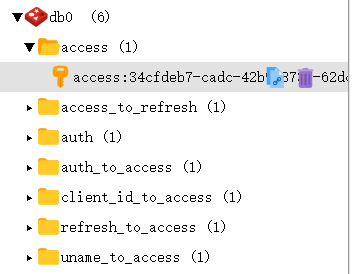原因是Spring 版本兼容问题
参考: https://blog.csdn.net/smollsnail/article/details/78954225
继承 RedisTokenStore 修改为红字部分
/** * User: laizhenwei * Date: 2018-04-13 Time: 9:49 * Description: */ @Component public class MyRedisTokenStore extends RedisTokenStore { private static final String ACCESS = "access:"; private static final String AUTH_TO_ACCESS = "auth_to_access:"; private static final String AUTH = "auth:"; private static final String ACCESS_TO_REFRESH = "access_to_refresh:"; private static final String REFRESH_TO_ACCESS = "refresh_to_access:"; private static final String CLIENT_ID_TO_ACCESS = "client_id_to_access:"; private static final String UNAME_TO_ACCESS = "uname_to_access:"; private final RedisConnectionFactory connectionFactory; private AuthenticationKeyGenerator authenticationKeyGenerator = new DefaultAuthenticationKeyGenerator(); private RedisTokenStoreSerializationStrategy serializationStrategy = new JdkSerializationStrategy(); private String prefix = ""; public MyRedisTokenStore(RedisConnectionFactory connectionFactory) { super(connectionFactory); this.connectionFactory = connectionFactory; } @Override public void storeAccessToken(OAuth2AccessToken token, OAuth2Authentication authentication) { byte[] serializedAccessToken = serialize(token); byte[] serializedAuth = serialize(authentication); byte[] accessKey = serializeKey(ACCESS + token.getValue()); byte[] authKey = serializeKey(AUTH + token.getValue()); byte[] authToAccessKey = serializeKey(AUTH_TO_ACCESS + authenticationKeyGenerator.extractKey(authentication)); byte[] approvalKey = serializeKey(UNAME_TO_ACCESS + getApprovalKey(authentication)); byte[] clientId = serializeKey(CLIENT_ID_TO_ACCESS + authentication.getOAuth2Request().getClientId()); RedisConnection conn = getConnection(); try { conn.openPipeline(); conn.stringCommands().set(accessKey, serializedAccessToken); conn.stringCommands().set(authKey, serializedAuth); conn.stringCommands().set(authToAccessKey, serializedAccessToken); if (!authentication.isClientOnly()) { conn.rPush(approvalKey, serializedAccessToken); } conn.rPush(clientId, serializedAccessToken); if (token.getExpiration() != null) { int seconds = token.getExpiresIn(); conn.expire(accessKey, seconds); conn.expire(authKey, seconds); conn.expire(authToAccessKey, seconds); conn.expire(clientId, seconds); conn.expire(approvalKey, seconds); } OAuth2RefreshToken refreshToken = token.getRefreshToken(); if (refreshToken != null && refreshToken.getValue() != null) { byte[] refresh = serialize(token.getRefreshToken().getValue()); byte[] auth = serialize(token.getValue()); byte[] refreshToAccessKey = serializeKey(REFRESH_TO_ACCESS + token.getRefreshToken().getValue()); conn.set(refreshToAccessKey, auth); byte[] accessToRefreshKey = serializeKey(ACCESS_TO_REFRESH + token.getValue()); conn.set(accessToRefreshKey, refresh); if (refreshToken instanceof ExpiringOAuth2RefreshToken) { ExpiringOAuth2RefreshToken expiringRefreshToken = (ExpiringOAuth2RefreshToken) refreshToken; Date expiration = expiringRefreshToken.getExpiration(); if (expiration != null) { int seconds = Long.valueOf((expiration.getTime() - System.currentTimeMillis()) / 1000L) .intValue(); conn.expire(refreshToAccessKey, seconds); conn.expire(accessToRefreshKey, seconds); } } } conn.closePipeline(); } finally { conn.close(); } } private RedisConnection getConnection() { return connectionFactory.getConnection(); } private static String getApprovalKey(OAuth2Authentication authentication) { String userName = authentication.getUserAuthentication() == null ? "" : authentication.getUserAuthentication().getName(); return getApprovalKey(authentication.getOAuth2Request().getClientId(), userName); } private static String getApprovalKey(String clientId, String userName) { return clientId + (userName == null ? "" : ":" + userName); } private byte[] serialize(Object object) { return serializationStrategy.serialize(object); } private byte[] serializeKey(String object) { return serialize(prefix + object); } private byte[] serialize(String string) { return serializationStrategy.serialize(string); } }
@Bean public TokenStore redisTokenStore(){ return new MyRedisTokenStore(redisConnectionFactory); }
@Override public void configure(AuthorizationServerEndpointsConfigurer endpoints){ endpoints.tokenStore(redisTokenStore()) .authenticationManager(authenticationManager).userDetailsService(userDetailsService); }


